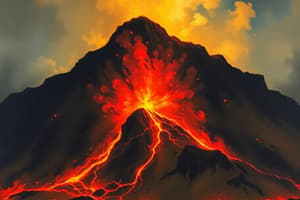Podcast
Questions and Answers
What is a mantle plume?
What is a mantle plume?
Upwelling of material through Earth's mantle.
From which depths can mantle plumes originate?
From which depths can mantle plumes originate?
From 2900 km (core-mantle boundary) or 660 km (transition zone).
The head of the plume can be about ______ km if coming from the D layer.
The head of the plume can be about ______ km if coming from the D layer.
1000
What are the types of plume?
What are the types of plume?
Ocean island basalt is characterized by being depleted in incompatible elements.
Ocean island basalt is characterized by being depleted in incompatible elements.
Match the following hotspots with their corresponding features:
Match the following hotspots with their corresponding features:
What is the approximate temperature difference of a plume compared to the surrounding asthenosphere?
What is the approximate temperature difference of a plume compared to the surrounding asthenosphere?
What is a hotspot?
What is a hotspot?
What can cause plumes to be generated within the D layer?
What can cause plumes to be generated within the D layer?
Flashcards are hidden until you start studying
Study Notes
Mantle Plumes
- Mantle plumes are upwellings of hot material from Earth's mantle, rising from the core-mantle boundary (2900 km) or the transition zone (660 km).
- Their shape resembles a mushroom with a head and a tail (conduits).
- When reaching the base of the lithosphere, plumes can have a head diameter of up to 2000 km (from the core-mantle boundary) or 1000 km (from the transition zone).
- Mantle plumes are important because they explain geological features not explained by plate tectonics, such as intraplate volcanism, ocean island basalt, and continental flood basalts.
Types of Plumes
- Primary plumes (Morganian plumes) originate from the core-mantle boundary (D" layer).
- Secondary plumes originate from shallower depths within the transition zone.
Effects of Plumes
- Oceanic island chains are created by the movement of tectonic plates over stationary hotspots, such as the Hawaiian Islands.
- Oceanic island basalt is enriched in incompatible elements.
Examples of Hotspots
- Afar
- Azore
- Bouvet
- Cameron
- Eifel
- Reunion
- Kerguelen
- Iceland (2° plume)
- Hawaii
- Tristan
Deccan Traps and Rajmahal Traps
- The Deccan Traps are a result of the Indian plate drifting over the Reunion hotspot.
- The Rajmahal Traps are formed by the interaction of the Indian plate with the Kerguelen hotspot.
Formation of Plumes
- Plumes are generated by instability in the D" layer due to:
- Heat extraction from the core.
- Descending slabs into the deep mantle.
Upward Journey of Plumes
- Plumes can:
- Disturb phase transition boundaries.
- Entrain mantle material.
- Impinge at the base of the lithosphere.
Temperature of Plumes
- Plumes are estimated to be approximately 300°C hotter than the surrounding asthenosphere.
Studying That Suits You
Use AI to generate personalized quizzes and flashcards to suit your learning preferences.




